03.07.2021: As a welcome change from June, I managed to go flying today. There would have been the general assembly meeting of the Experimental Aviation Association in Birrfeld today, but going there would have taken the whole day, so I reluctantly skipped that one despite it being an event I always try to attend. Instead I went flying for a good hour early in the afternoon, as some rain front has been announced for late afternoon. On Monday/Tuesday I will do the annual maintenance / inspection, so that was also a kind of check-flight to see what might have to be done in addition to the standard list.
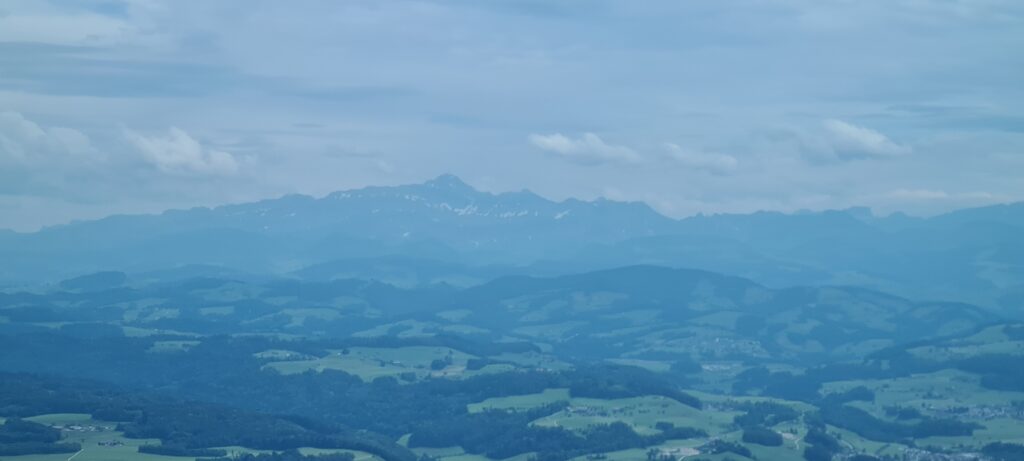
Below one can see that the rain front moving in from the west. Despite that, conditions were however extremely calm, and visibility excellent except in the alps.

Most mountain passes were obscured by clouds, so I stayed in the plains. Listening to Zurich information I could hear that a lot of people were flying today, probably due to the weather forecast predicting some storms and rain for Sunday. We’ve had quite some rain over the last few weeks, with some hail-storms and flooding throughout the country, as it is also the peak period of the annual snow melt. So I guess quite some hobby pilots are still below their flying quota.

Below a view of the Säntis, with only some patches of snow left. When looking at similar pictures in the May entry one can see the difference in snow coverage, some of those patches left will stay throughout summer.

04.07.2021: The weather was quite poor today, which didn’t really matter as I had to prepare the annual inspection on my SportCruiser, which is planned for tomorrow and the day after. As rain was announced for the afternoon we decided to go for a longer walk along lake of Constance already in the morning. There we observed two Zeppelin NTs, which are a common sight around lake of Constance, but rarely seen as pair.
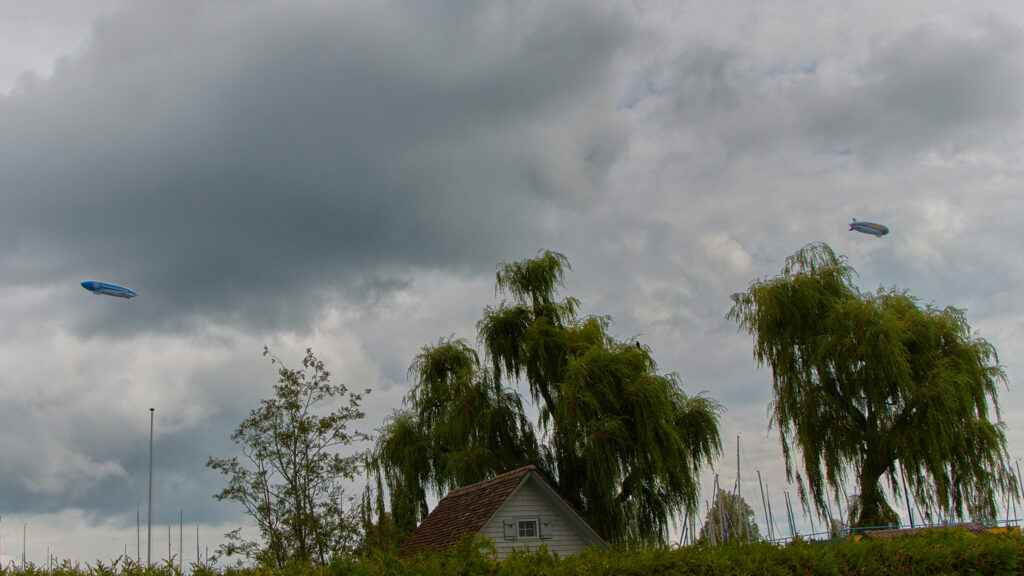
One of them was in Goodyear colours, D-LZFN, SN02, the first serial model built in 2001. Goodyear operates three Zeppelin NTs in the US, this one is operated by Zeppelin in behalf of Goodyear for their activities in Europe. It is mostly being used at Formula 1 races and other big events, but in between also for sightseeing flights from Friedrichshafen and from other places.
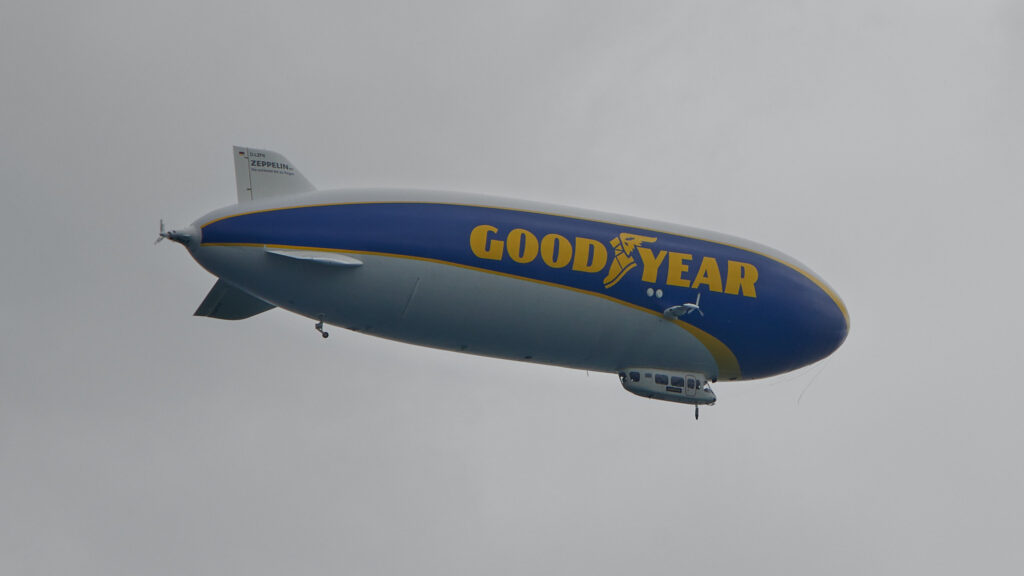
The second one, D-LZNT, SN04 built in 2008, was in ZF colours (Zahnradfabrik Friedrichshafen). ZF is a major shareholder of Zeppelin.
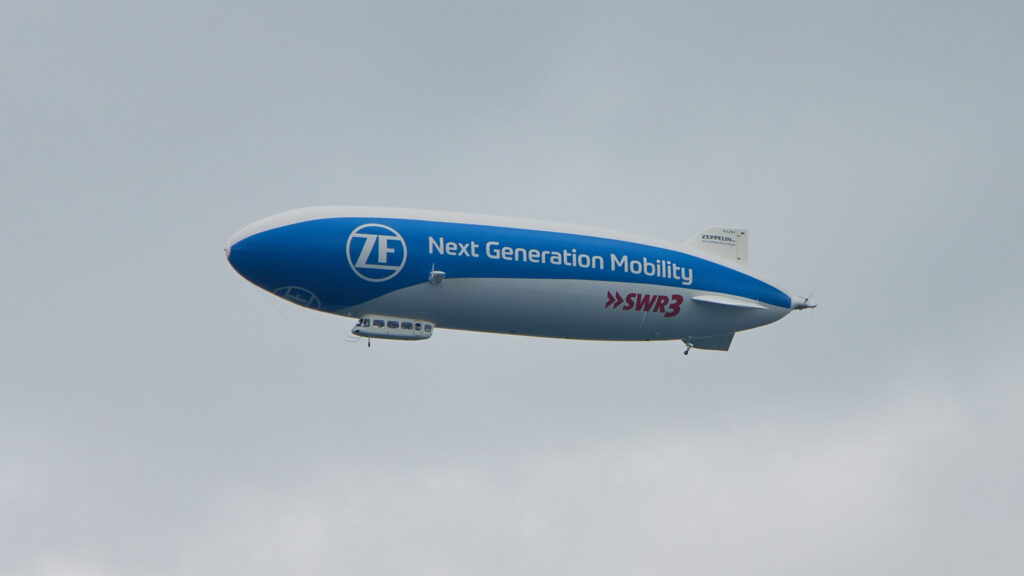
The Goodyear Zeppelin then turned north and disappeared in the clouds, which looked pretty cool.

In May 2015 my wife and I were lucky to obtain tickets for a Zeppelin flight operated by Edelweiss Air, a Swiss charter airline. They offered them to celebrate their 20th anniversary at very reasonable prices. That was a truly amazing experience.
06.07.2021: Yesterday and today were days fully devoted to “flying”, but without much flying.
Yesterday morning I first I went to get my medical renewed, which was no problem. Swiss authorities however introduced a new questionnaire to be completed as part of the check, which shall help to detect mental issues the candidate might have. That is a consequence of the crash of Germanwings Flight 9525 in 2015, which was deliberately caused by the copilot who had hidden his treatment for suicidal tendencies from his employer. So now even hobby pilots like me have to fill a questionnaire with some pretty weird, or even straight ludicrous questions. They’d rather change doctor’s confidentiality rules for people working in highly safety critical jobs, allowing them to report such issues
Then I did the annual check on my SportCruiser, which again went well. I found no issues, but noticed that I have to do the transponder check. As Kuerzi Avionics stopped doing any work on general aviation aircraft I will have to find out where I can do that.
Once finished I of course had to do a short check-flight, especially as the weather was for once very nice.
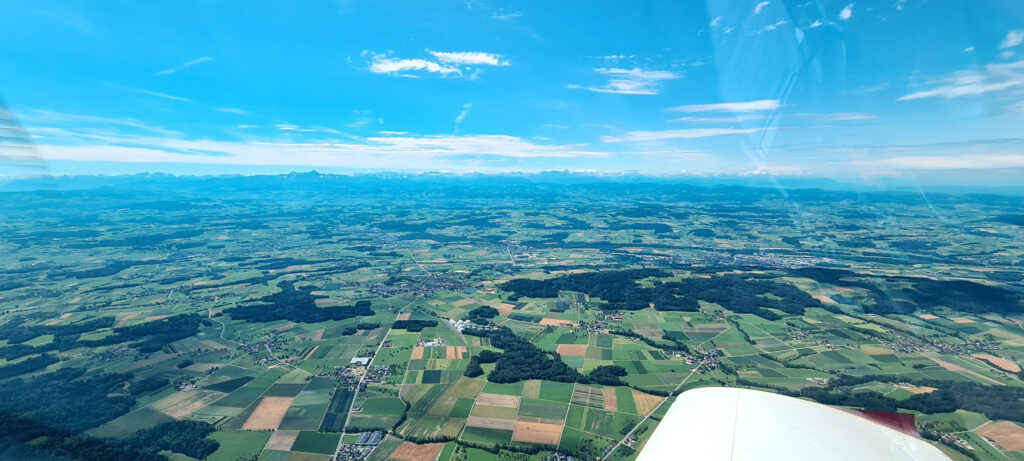
20.07.2021: Last year I decided to digitise my old slides and negatives. I did attempts with a cheap scanner, with a rented midrange scanner and with a commercial service, which all produced somehow unsatisfactory results. This was especially true for the slides I took during my stay in Canada in 1985 in my first job as an engineer, as those slides have deteriorated over the years. Doing some internet search I came across a Youtube video which described an alternative method. It is based on using a DSLR camera, as well as a backlit table, from which the slides, respectively negatives are photographed, followed by post processing in a photo editing software. As I had recently bought a new Canon EOS 90D I did a quick setup, starting with an improvised backlight table using some LEDs from my landing light project under a thicker sheet of white paper put in between two pieces of glass from old picture frames. I then put the Canon on an old tripod, looking down onto the glass plate, and covered everything with a black garbage bag. Even by only using Adobe Photoshop Elements for processing, the results looked a lot better than the three previous attempts, so started looking for a better suited photo editing software.
After comparing various alternatives I went for Capture One, a Danish tool from a company called Phase One, which also produces high end mid format digital cameras. There are many other photo editing tools, such Adobe Photoshop, Corel PaintShop Pro, Skylum Luminar, Adobe Lightroom etc., which all have their advantages and disadvantages. What I liked in Capture One is the possibility to connect the camera via USB or WLAN to the PC, so that photos taken are immediately copied to the computer and shown in the tool, which makes digitising pictures, slides and negatives much easier. Capture One can also be bought straight without monthly licence payments, as some of the other tools, and all photo editing is done locally and not via the cloud. Finally, Capture One always keeps the raw input file as well as the corrections separated, even when producing JPG files from processed pictures. so any correction can again be changed at a later stage without loss of quality. The only drawback of Capture One is the fairly steep learning curve, but they provide excellent online training material, including professional training videos at no cost.
When editing my website over the last few months I noticed that the pictures taken my new smartphone, a Samsung Galaxy S20, are often at least as good or better than the ones taken with my the Canon, if taken with a similar focal length. The Canon is of course still a lot better for taking pictures with a longer focal length, when taking photos in poor lighting conditions or of fast moving subjects, but it is still surprising how far smartphone cameras have progressed. A bit of research showed that smartphones do a lot of picture optimisations based on recognising the subject or scene (that’s probably why they are called “smart”), while DSLR cameras typically don’t do this, or only for preselected scenes. Smartphones are also optimising contrast and colours for different areas of a picture, apply sharpening of edges, remove haze etc.
Having used Capture One for a while now, I have tried it on some of my flying pictures to e.g. remove the blueish look in most of them, which is caused by the tinted canopy. I have then also started using some of other correction functions. To get the best results I started taking pictures in RAW and JPG format a while ago, as RAW data is much better suited for applying corrections that JPG. Doing this I noticed that even the S20 can take pictures in RAW format, but only with the main camera with no optical or digital zooming.
I’m writing this here as from now on some of the pictures I post might be slightly edited, but I’m only doing this to the point where the picture is closer to what I have seen with the eye, than what the camera has seen. A good example is the compensation of the blueish tint caused by the canopy, which the human eye corrects as it knows what colours the outside really has, while the camera can’t do that.
26.07.2021: A friend from Denmark is visiting us for a week, and as every time when he is here we try to do a bit of flying. Despite the weather being poor, we gave it a try today.
When we took off from Lommis there was a low but thin layer of clouds, with the base at around 2’400 ft, which is the circuit height in Lommis. So we had to fly a slightly lower circuit than usual until we found a hole big enough to get on top of that layer.
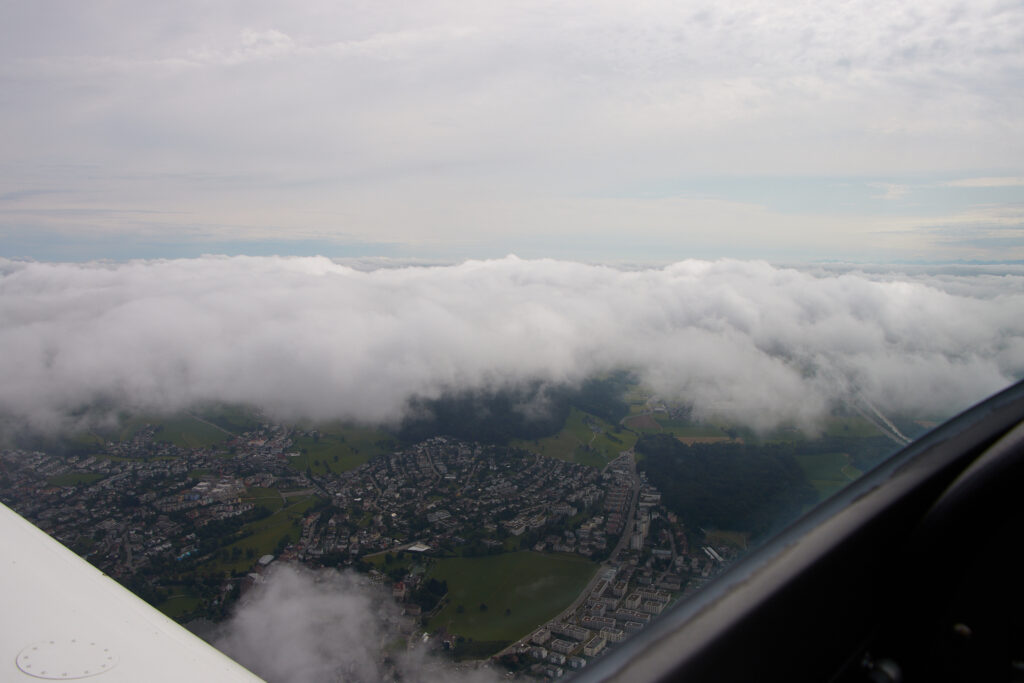
We then turned towards Säntis under another broken layer of clouds, which however had a base of around 10’000 ft.

The lower layer got less dense the closer we got to the mountains.
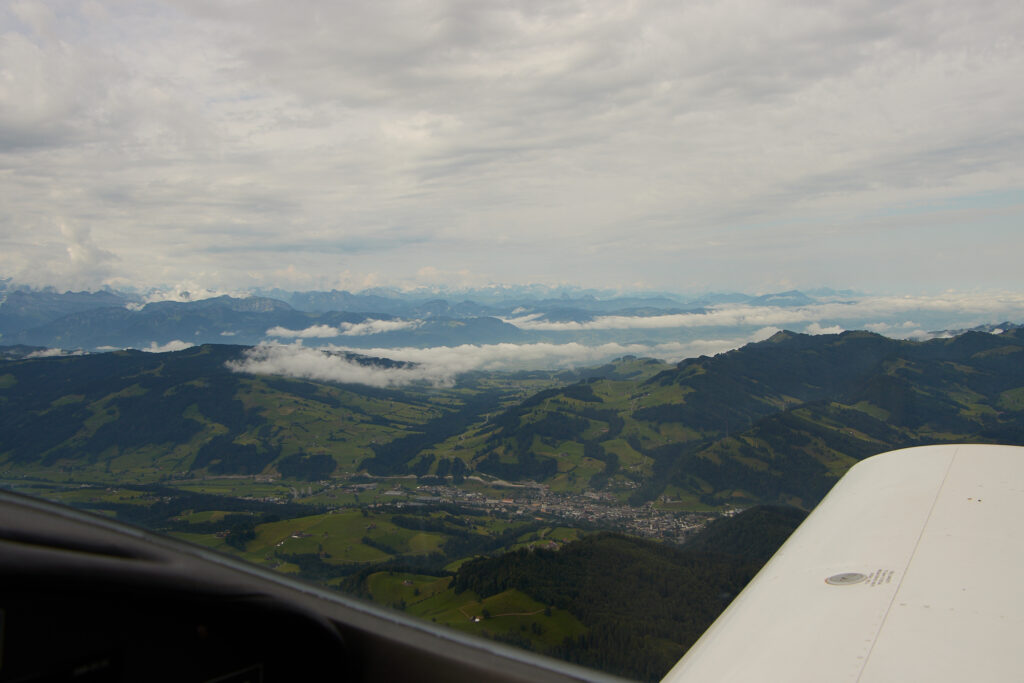
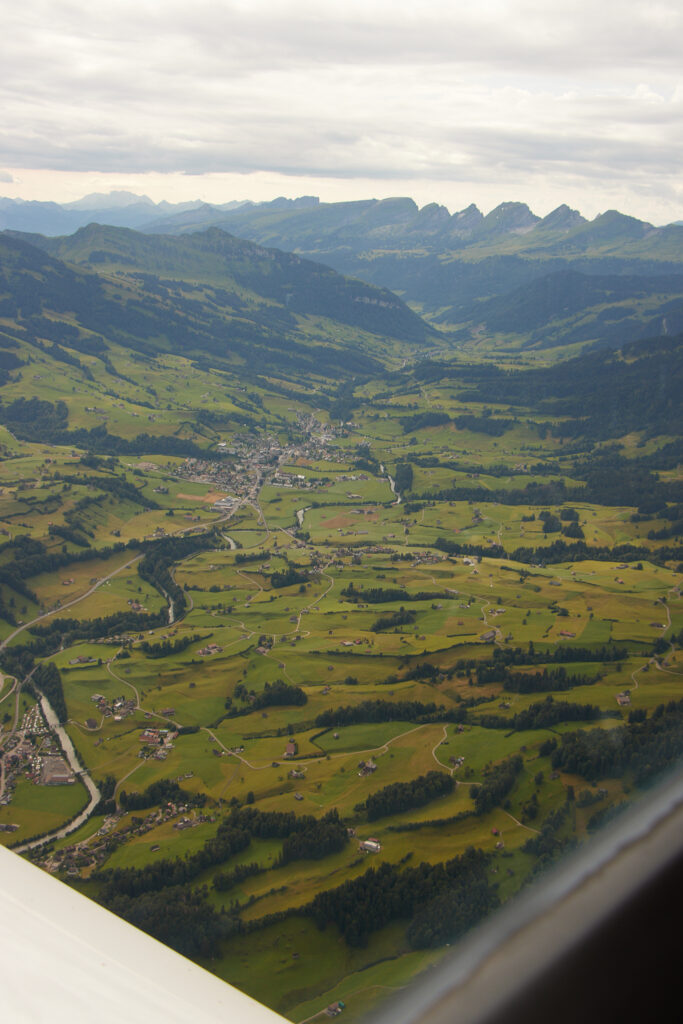
Below Lake of Zurich, with the city at the far end of the lake under clouds.

I like flying in these conditions, the mountains look much more spectacular than under perfect, blue sky conditions. And flying in such conditions is absolutely no problem, even if conditions would worsen there are ample airfields to land. There is one on the pictures above and below, you rarely don’t have an airfield in sight in Switzerland.
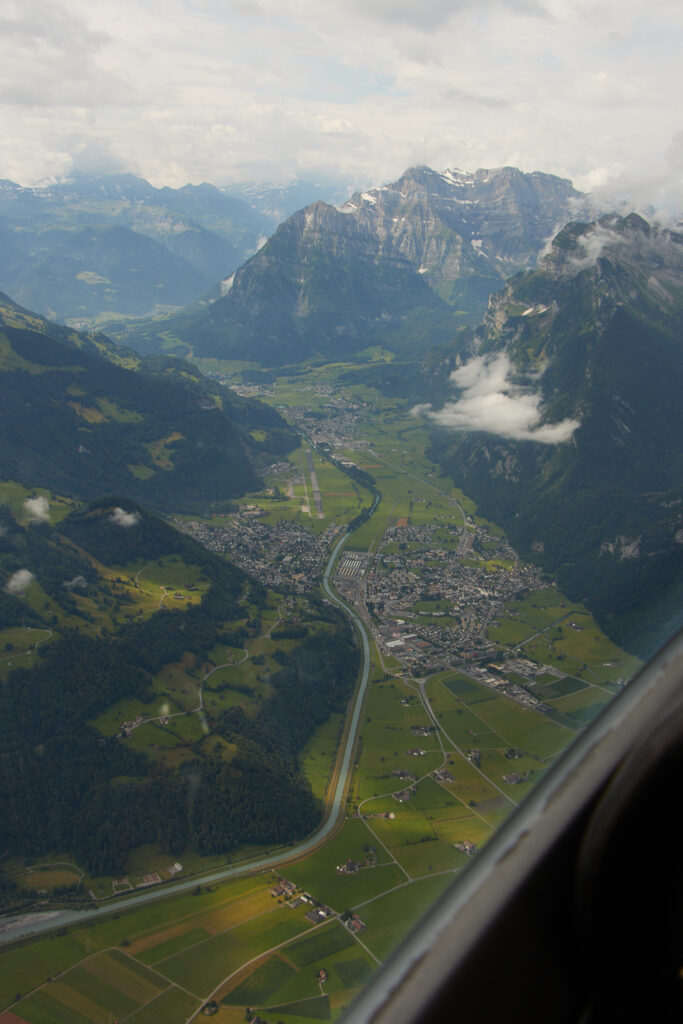

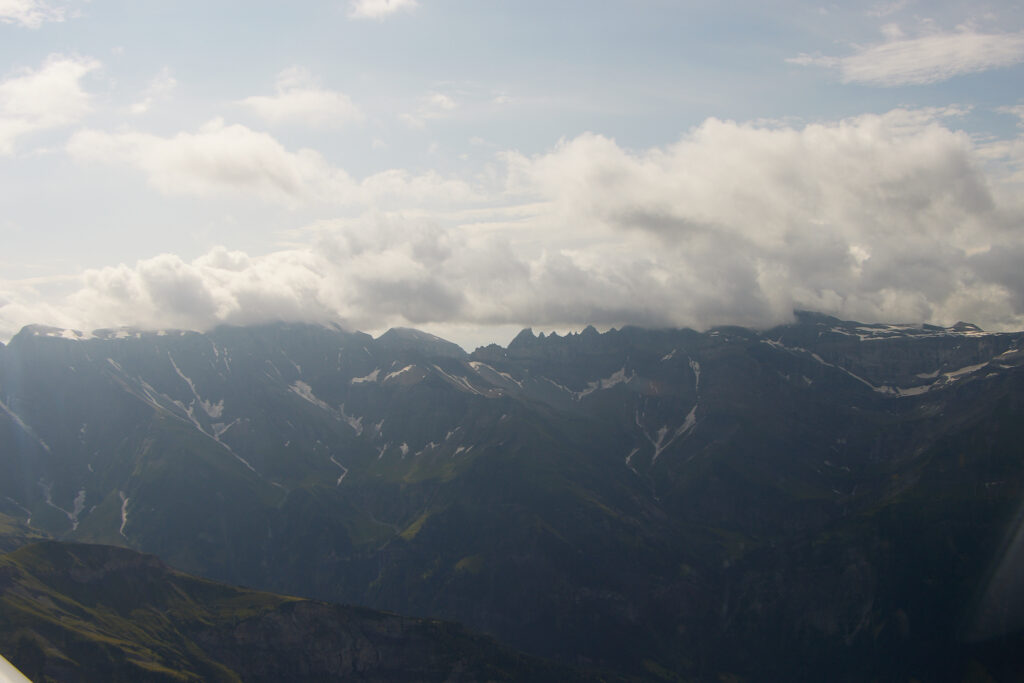
Below in the centre of the photo the Martinsloch, a hole of around 20 m diameter in a mountain.
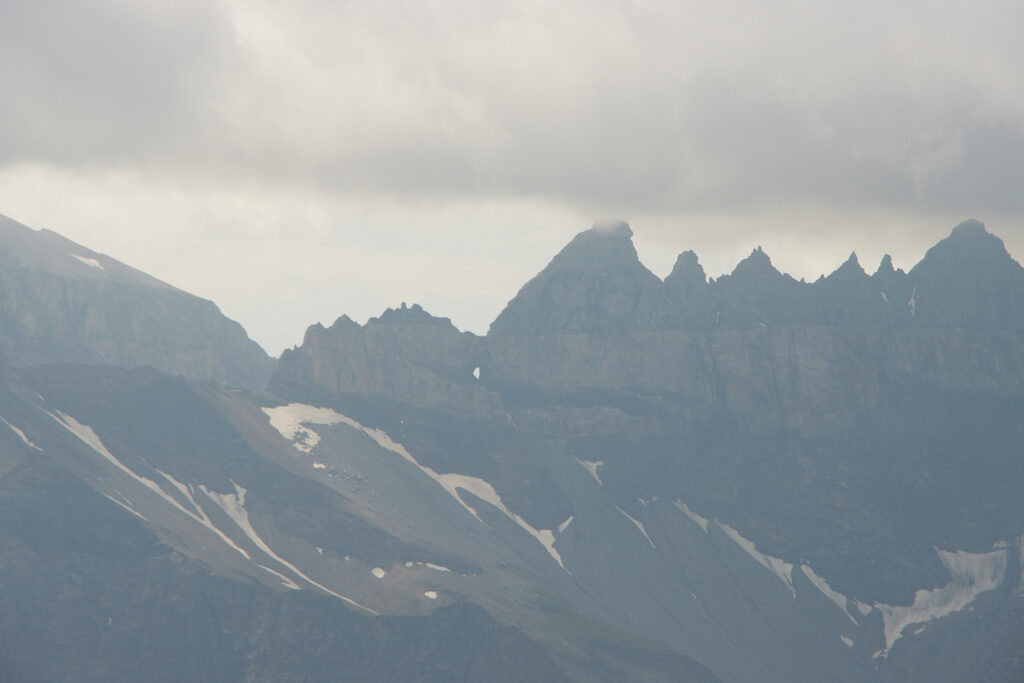
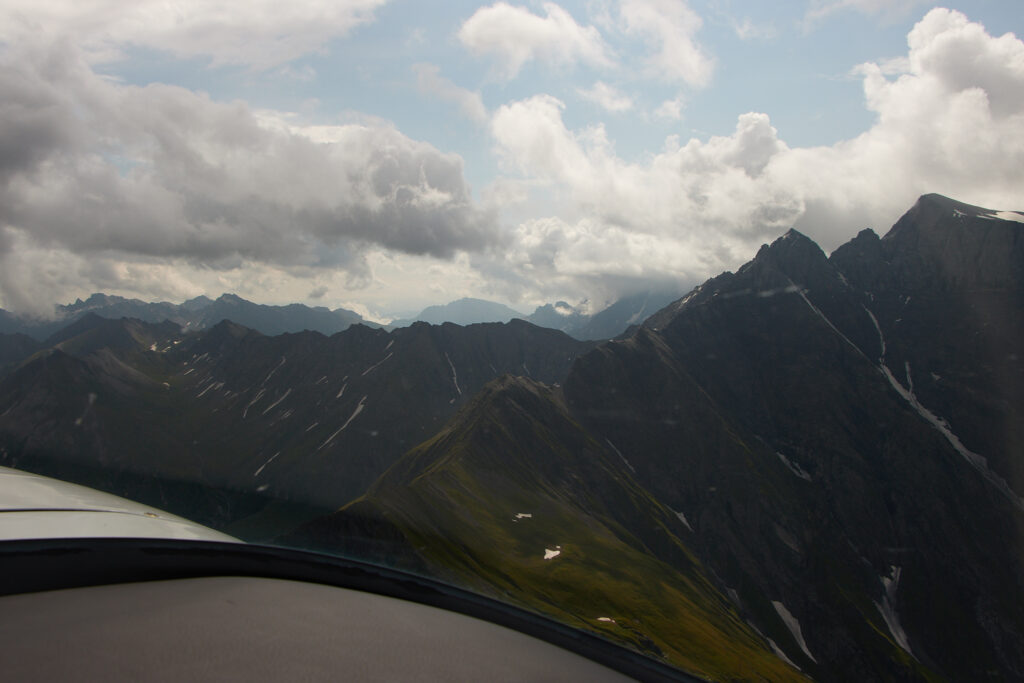
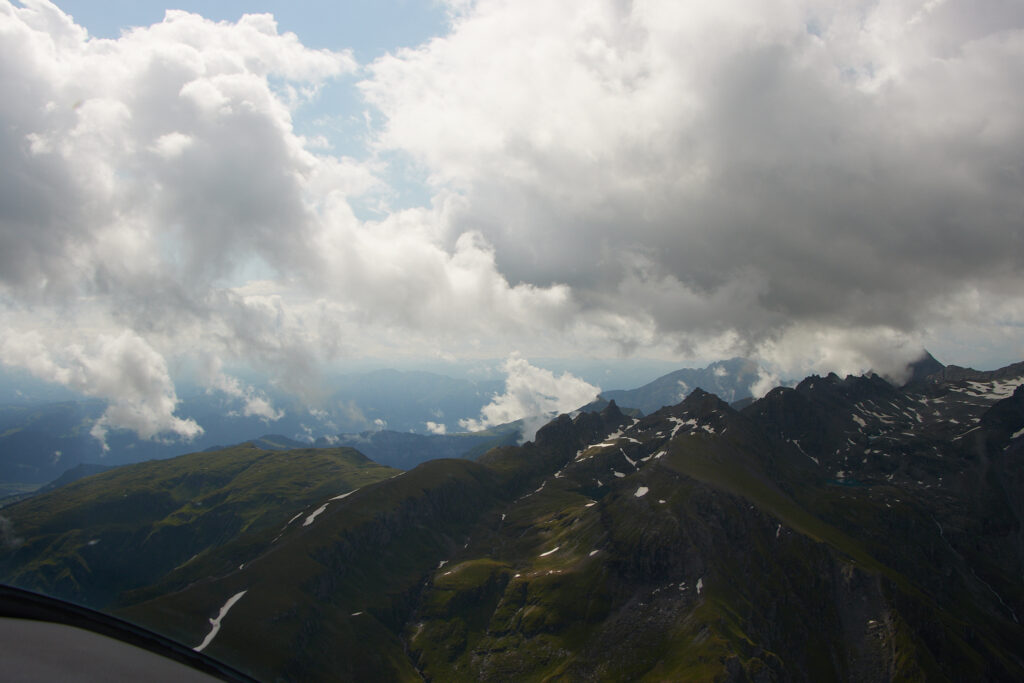
We continued east into the upper Rhine valley, with Switzerland on the left (western) side of the Rhine and Austria / Lichtenstein on the right side.

On our way back we saw to helicopters of the Air Force, probably on a formation flying exercise.

Heading back the thin layer has gotten more open, somewhere between few and scattered, as announced in the weather forecast.

27.07.2021: I had to go to Cossonay-Ville today, by car, so we decided to visit the Air Force Museum at Payerne Airbase on the way back. Already when stopping somewhere along Lake of Neuchâtel we saw a PC-9, which the Air Force uses for target towing, as well af for ECM, doing some low level exercises over the lake.
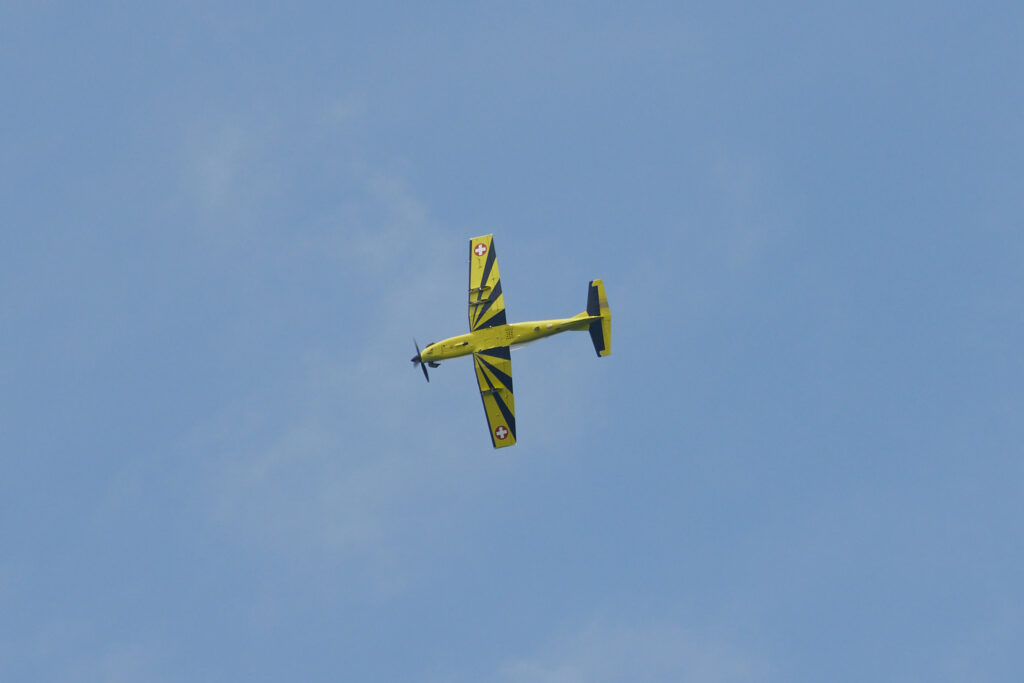
From there we headed to Payerne, where I unfortunately forgot to take a picture of the museum from the outside, so took one from Google Maps’ Street View function.
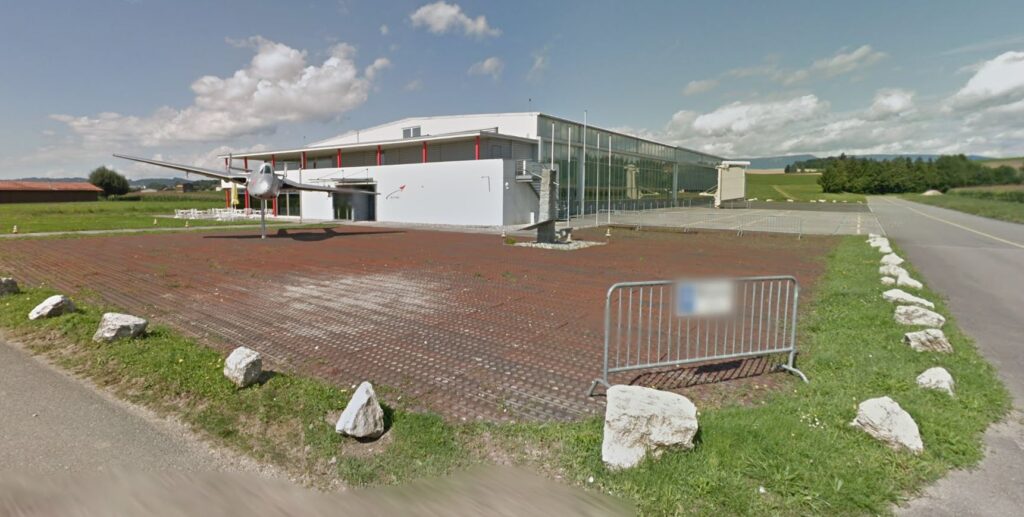
The museum is not very large, but they have all the planes the Air Force was flying when I was a bit younger, from the DH.100 Vampire via DH.112 Venom, Hawker Hunter, Mirage III and F-5 Tiger, as well as the Alouette II and III. Before we could however have a look at the exibits we heard the sould of a jet from the outside, so we went out onto the observarion platform, which can be seen on the picture above. The runway is only around 150 m from the platform, from where we could see one of the double seater F/A-18s, which had just landed.
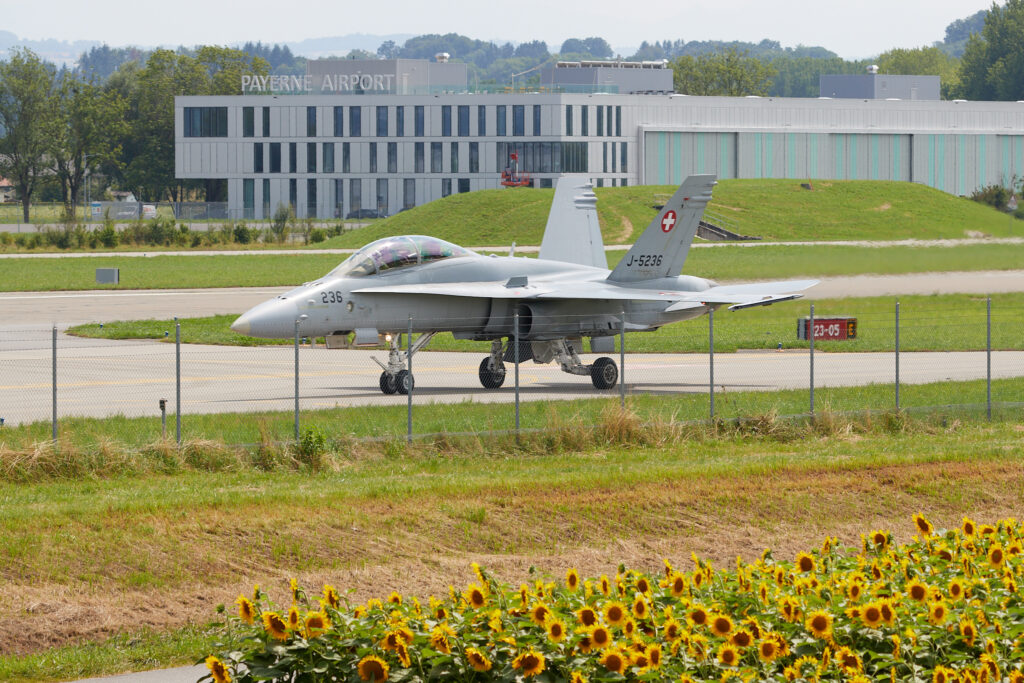
Shortly after we had gone inside again, we heard more aircraft noise, so out we went again. We could then see a full parade of aircraft taking off, starting with a Pilauts PC-7 trainer,…

…followed by two civil Cessna-172s.

After the Cessnas six F/A-18s took off, always lining up in pairs, but taking off one after the other.

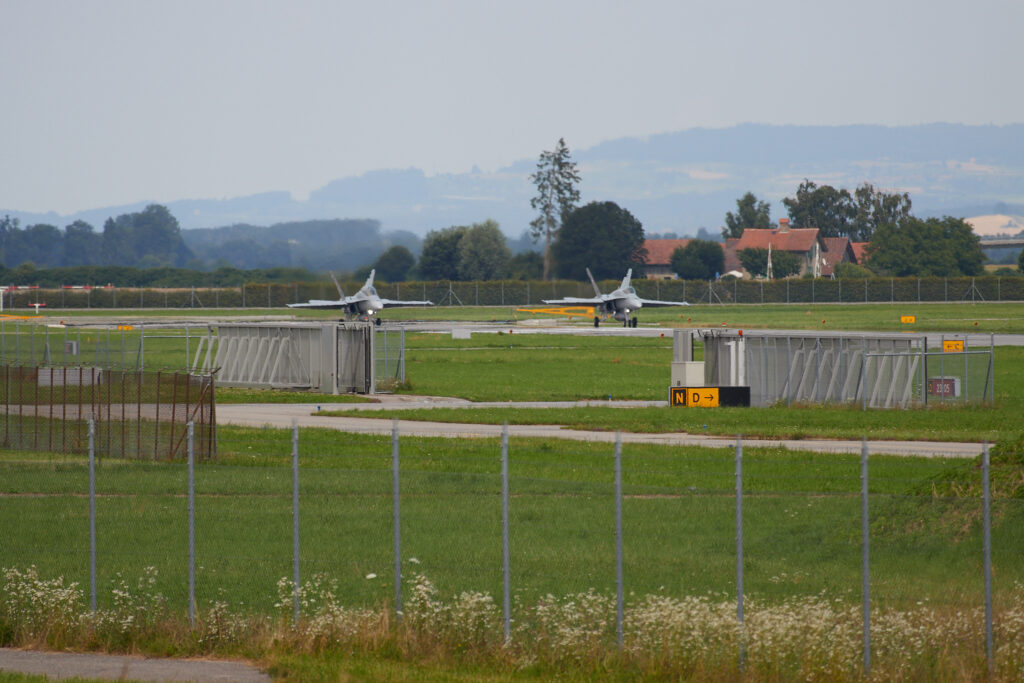

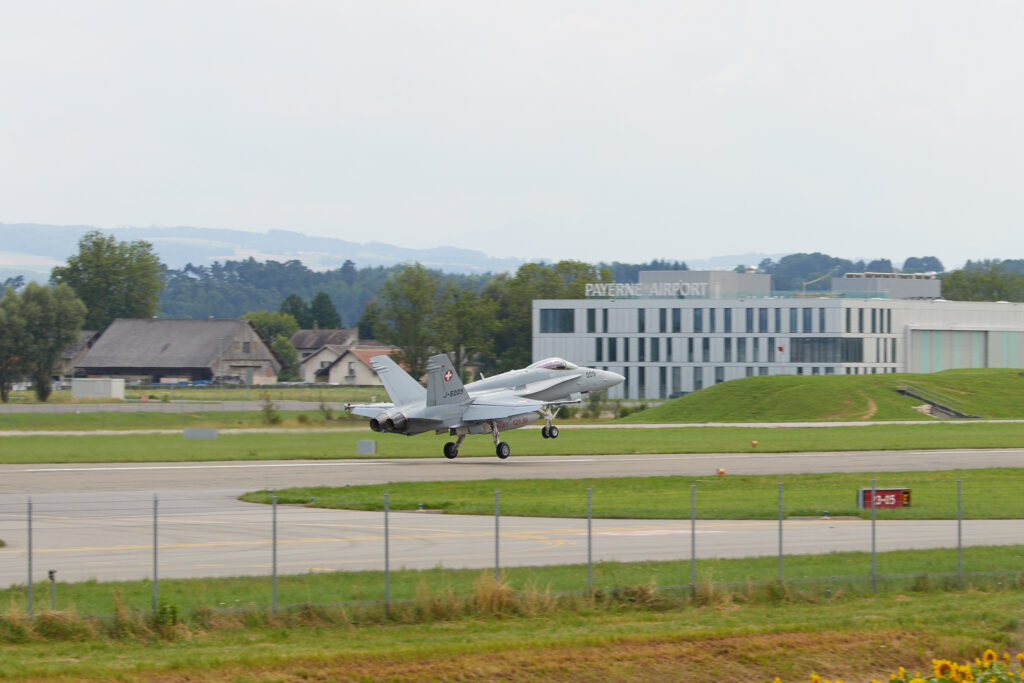
As if this wasn’t enough, a PC-9 also took off, the same type we had seen earlier over Lake of Neuchâtel.
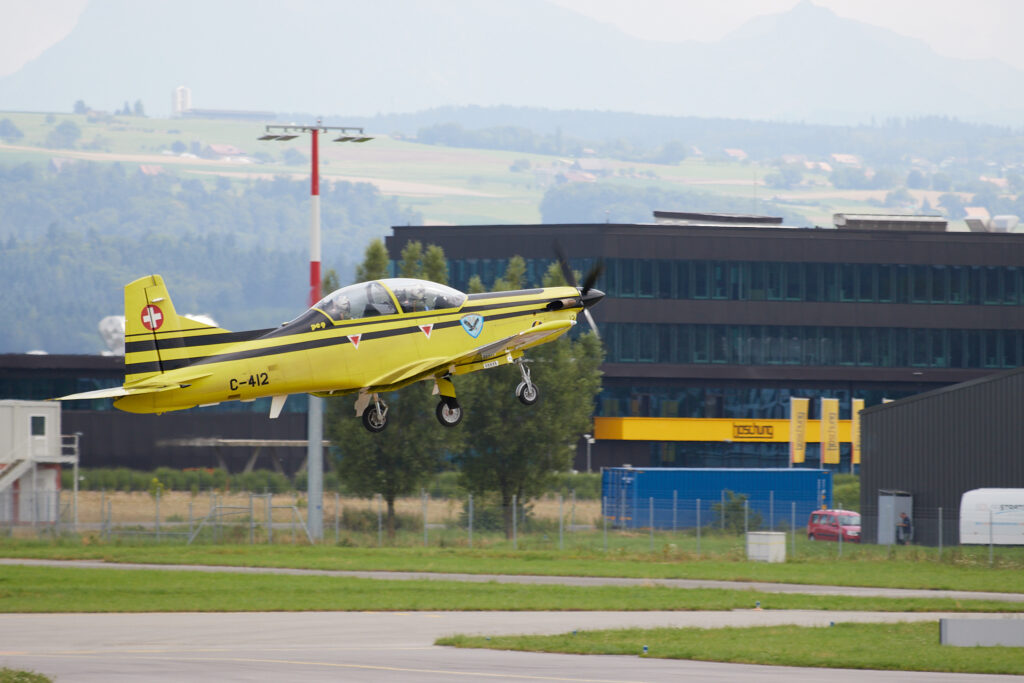
Once we had the impression that the last plane had taken off we went inside to finally have a look at all those vintage jets. When I went to school, the Swiss Air Force had around 500 jets in active service, 120 Vampires, 250 Venoms, 100 Hunters and 60 Mirage, later supplemented by another 60 Hunter and 72 Tiger. Today they operate 30 F/A-18s and around 20 Tiger, with another 25 in storage. Below a few impressions of the jets on display.
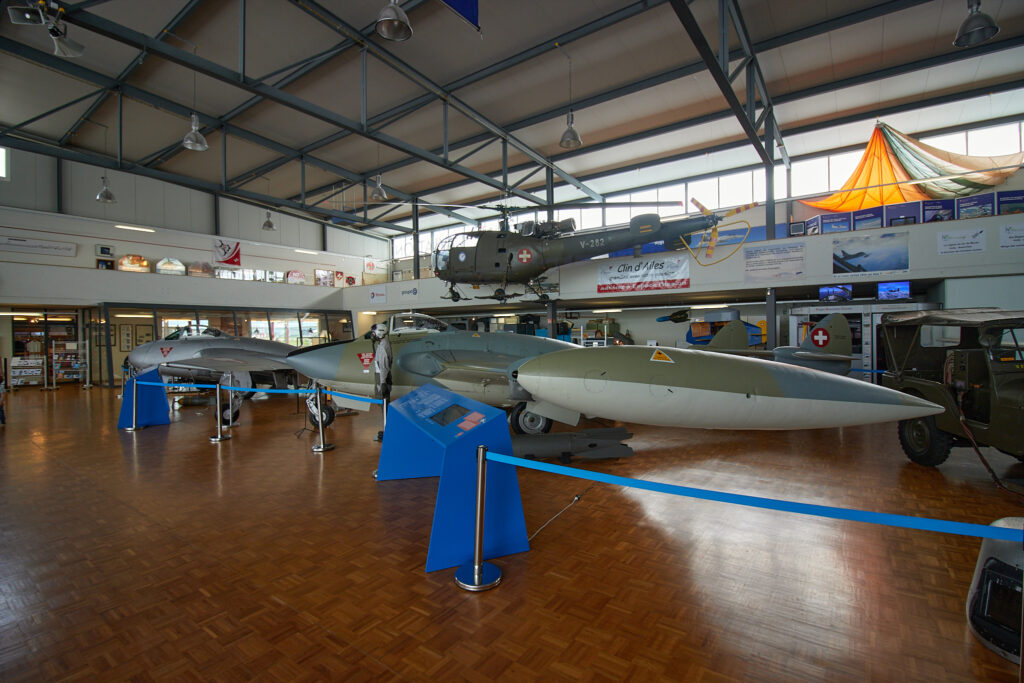

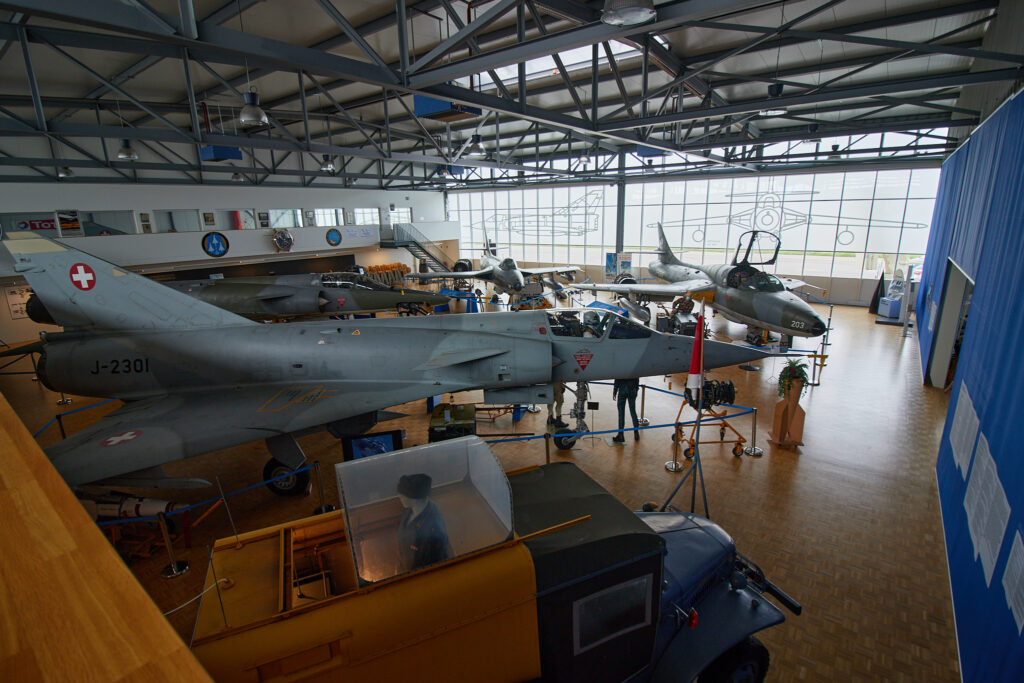


29.07.2021: The weather forecast was again predicting clouds and some rain, but only in the plains, with good weather predicted above 7’000 ft. So we decided to give it a try to fly to Matterhorn and then Samedan for lunch.
When we took off the situation was similar than three days ago, but the base was higher, at around 4’000 ft.
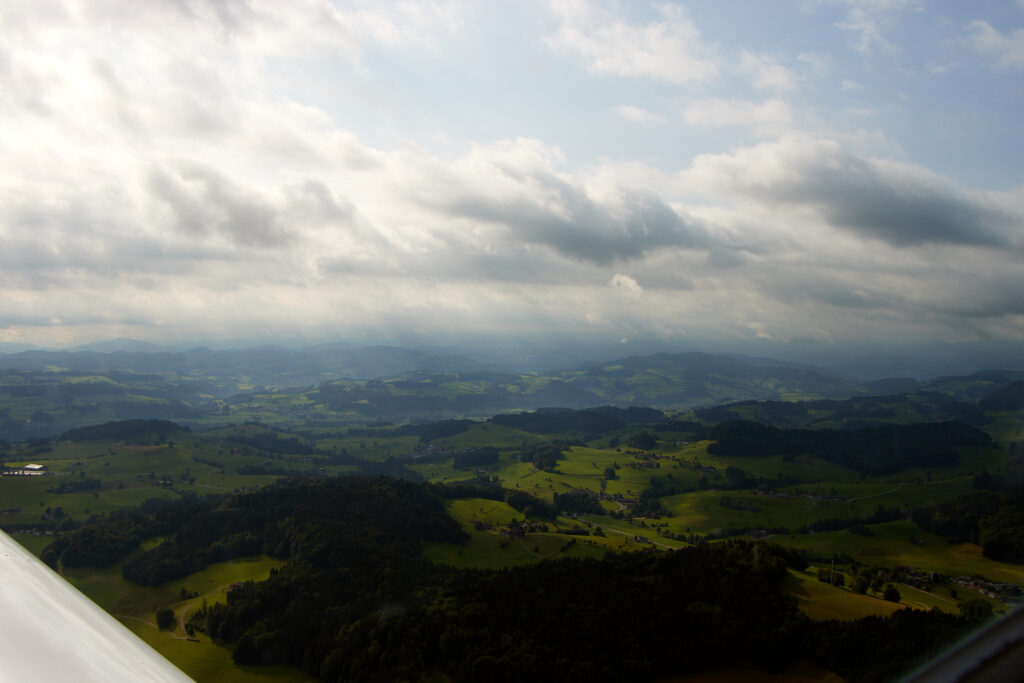

The cloud layer however got thicker the closer we got to the mountains, with only few, small holes.

Flying into the Muotta Valley we however found a large enough hole to climb through while maintaining the required minimum distance from clouds

Above the clouds the weather was as expected, perfectly blue sky from pole to pole.
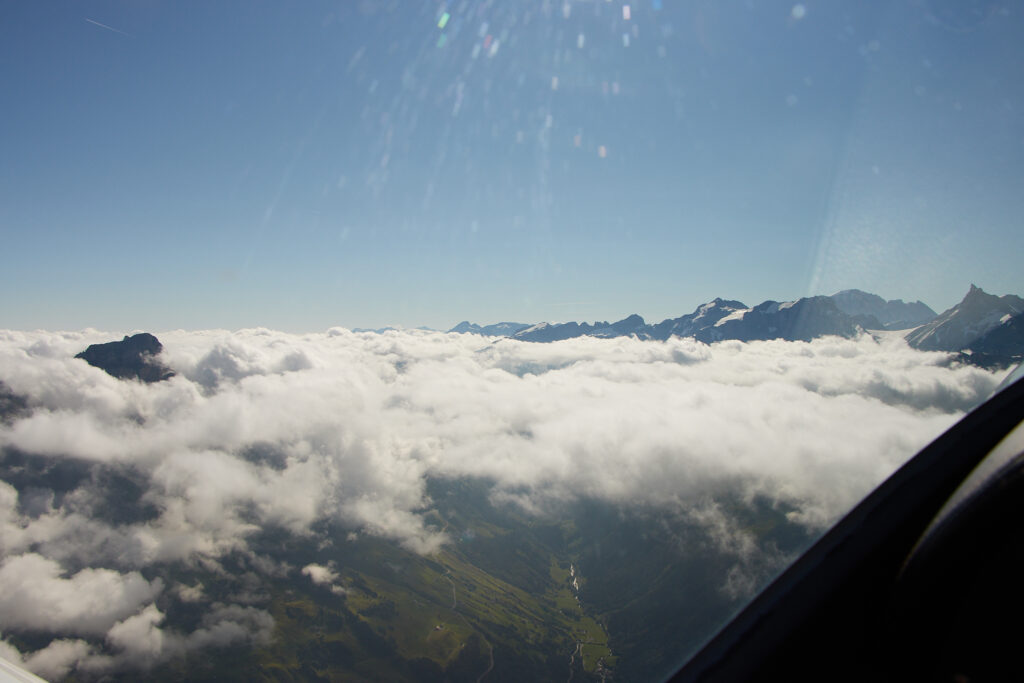
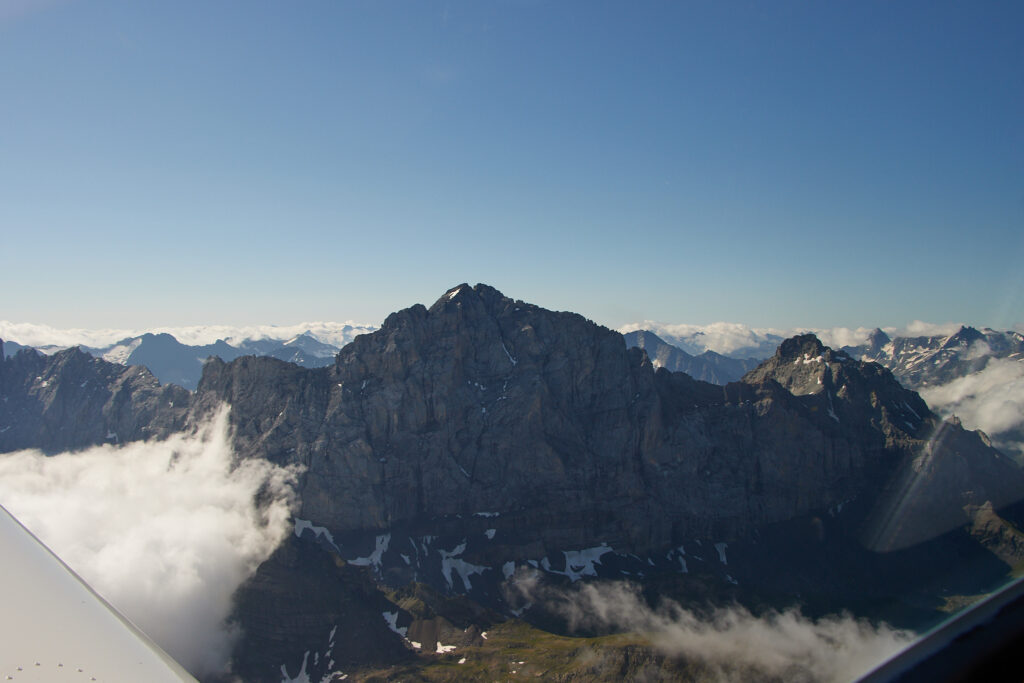
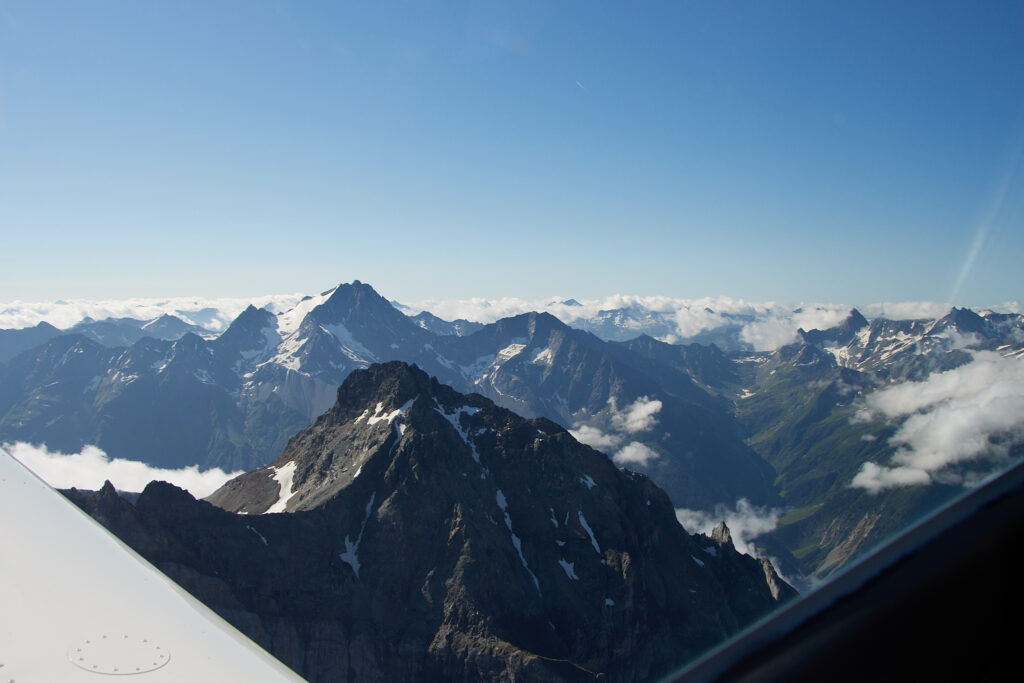
We passed the Titlis on the south side, on the north side there is a skiing area which is open even in Summer.

Soon after passing the Titlis we had a first view of Matterhorn, from a distance of around 100 km. This is where a smartphone camera fails, where else the Canon still delivers great pictures. I took this one with the EF-S 18-135 mm lense and some cropping of the picture, which thanks to the 32.5 Mpx sensor still produces a picture with sufficient resolution.

We then continued past Eiger, Mönch and Jungfrau (from left to right), looking out for climbers on the Eiger’s north face without success.
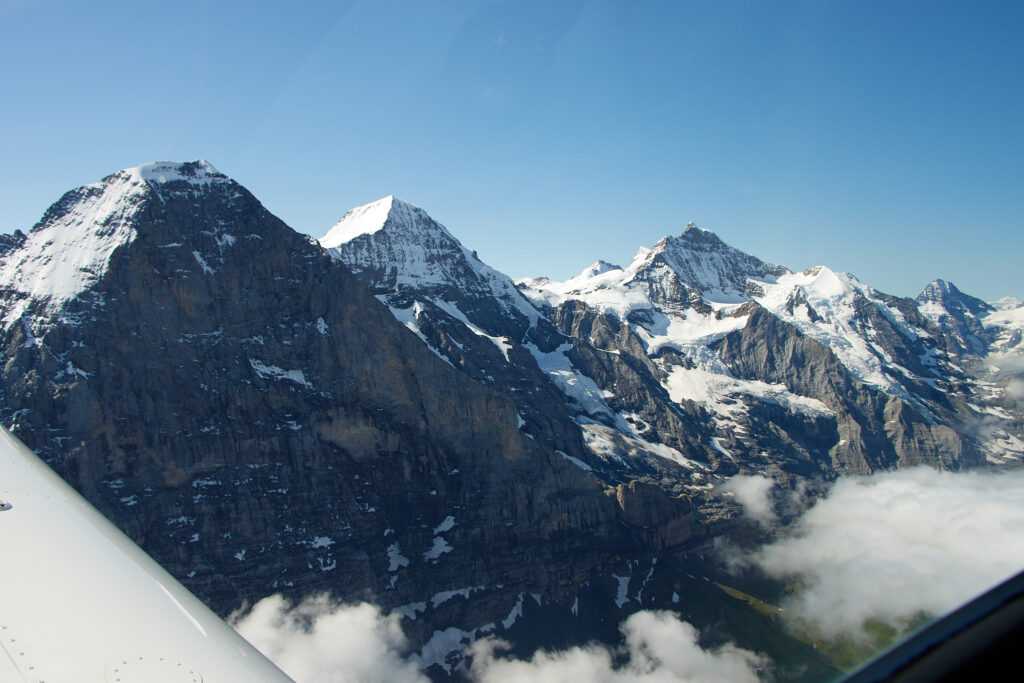
Flying at FL100 we were still significantly below the observatory between Mönch and Jungfrau, which is at 11’715 ft. We decided to continue south past the observatory, meaning we had to clime to around FL130 to have sufficient margin.
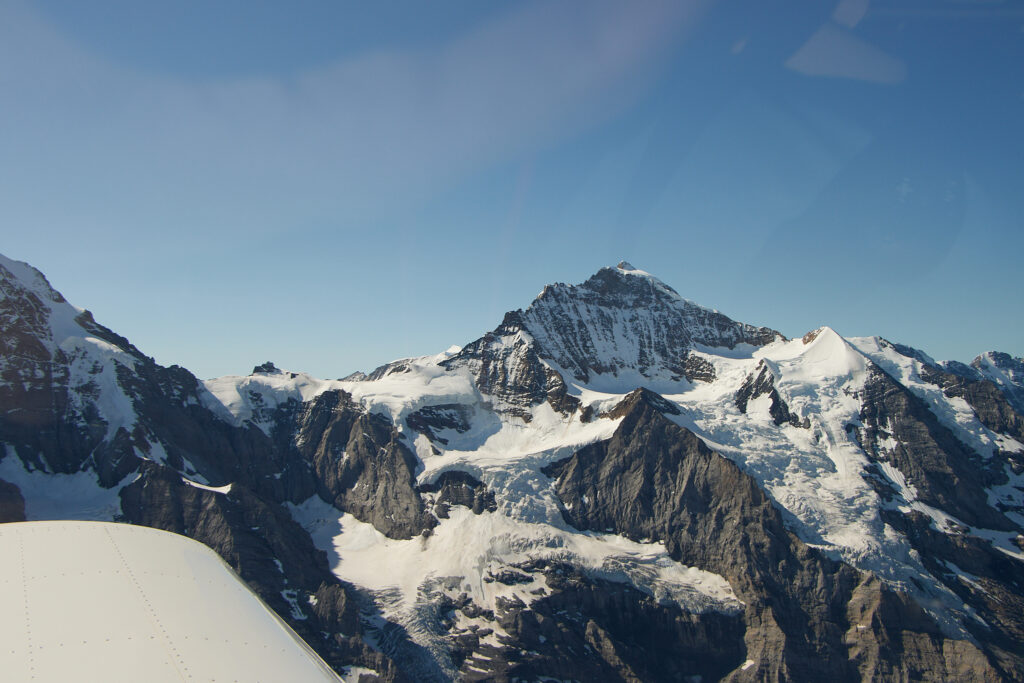
Below the observatory from around FL 135, I rather have a bit more margin than the recommended 1’000 ft.
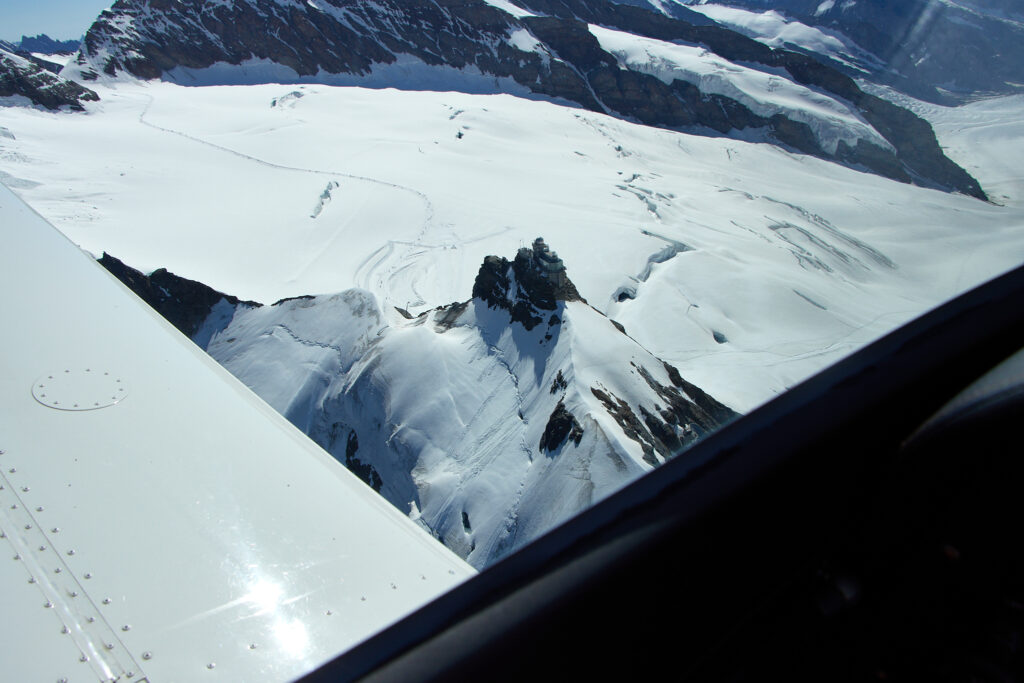
Looking back north one can see far into Germany, or in these conditions onto the layer of clouds over the plains.
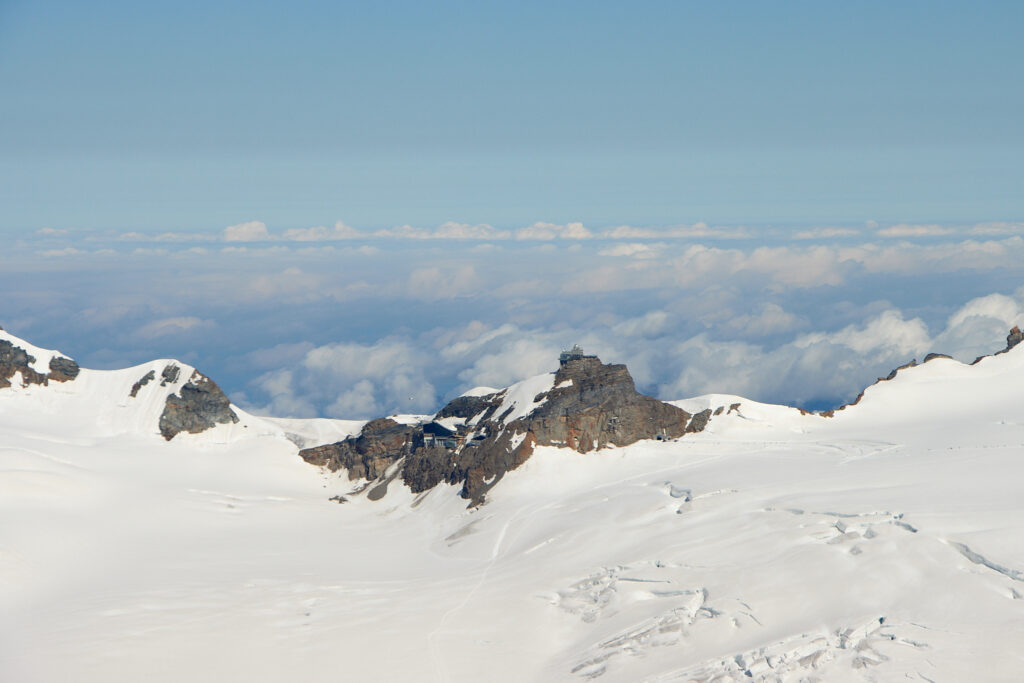
Another view at Matterhorn, this time from a distance of around 60 km.
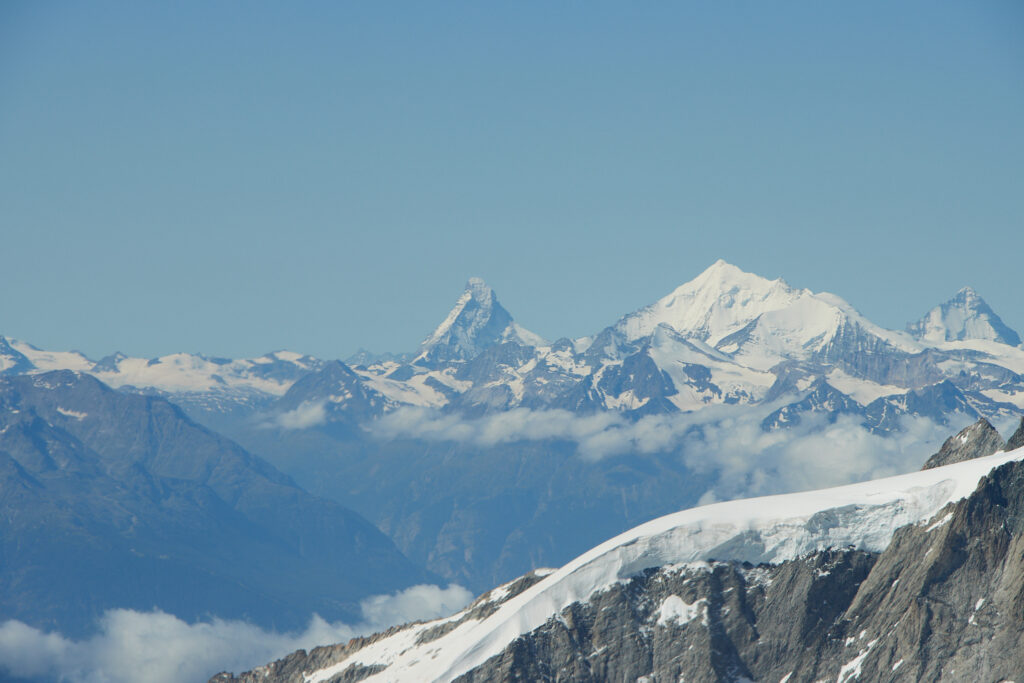
Again a look back over the Aletsch Glacier, the largest one in the alps, with Eiger, Mönch and Jungfrau in reverse order from right to left.

Looking west we could see Mont Blanc in the French Alps, around 100 km to the west through a bit of haze.
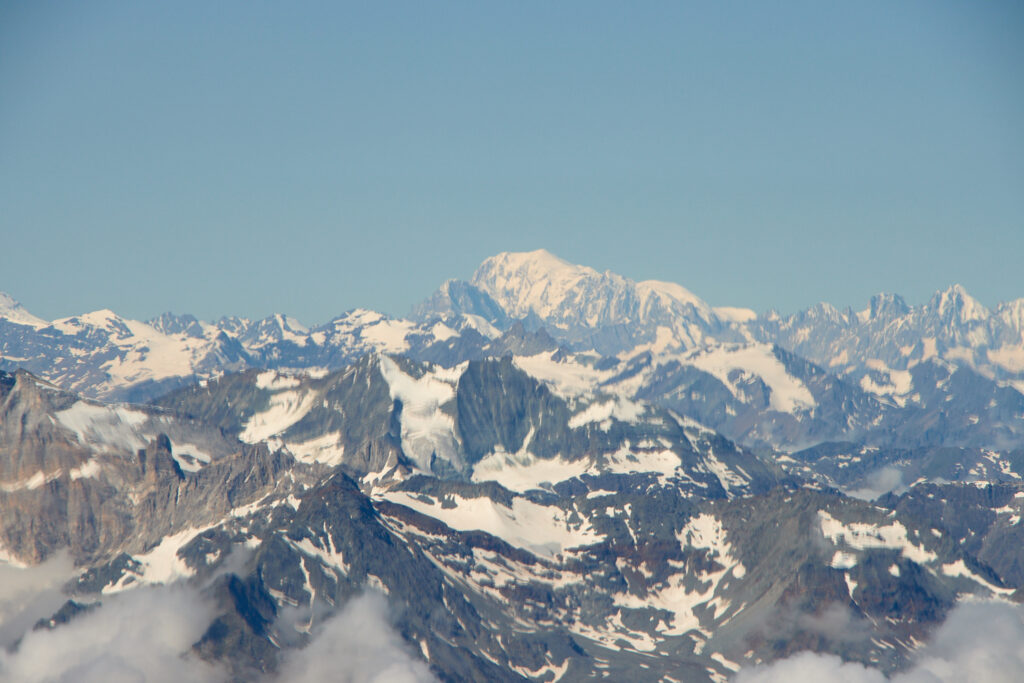
We then flew past Matterhorn, but not around it as the air was quite turbulent if you got too close, with around 35 kts of wind from the south at FL 125.
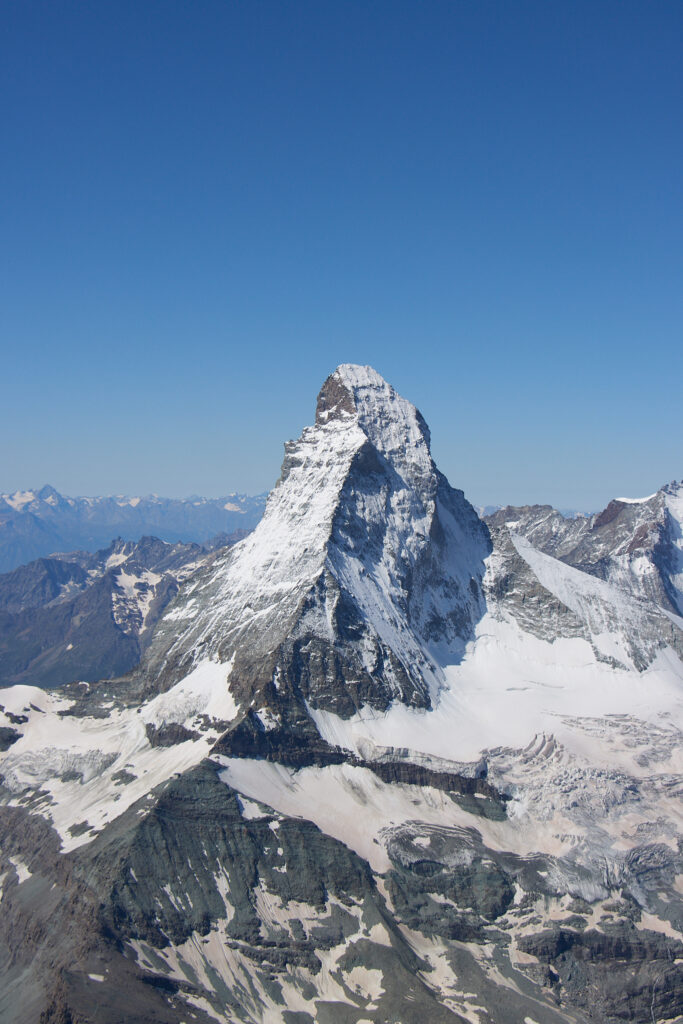
Once we had seen enough of Matterhorn we headed east, flying over the Furka pass, the canton of Tessin (under quite some clouds)…,
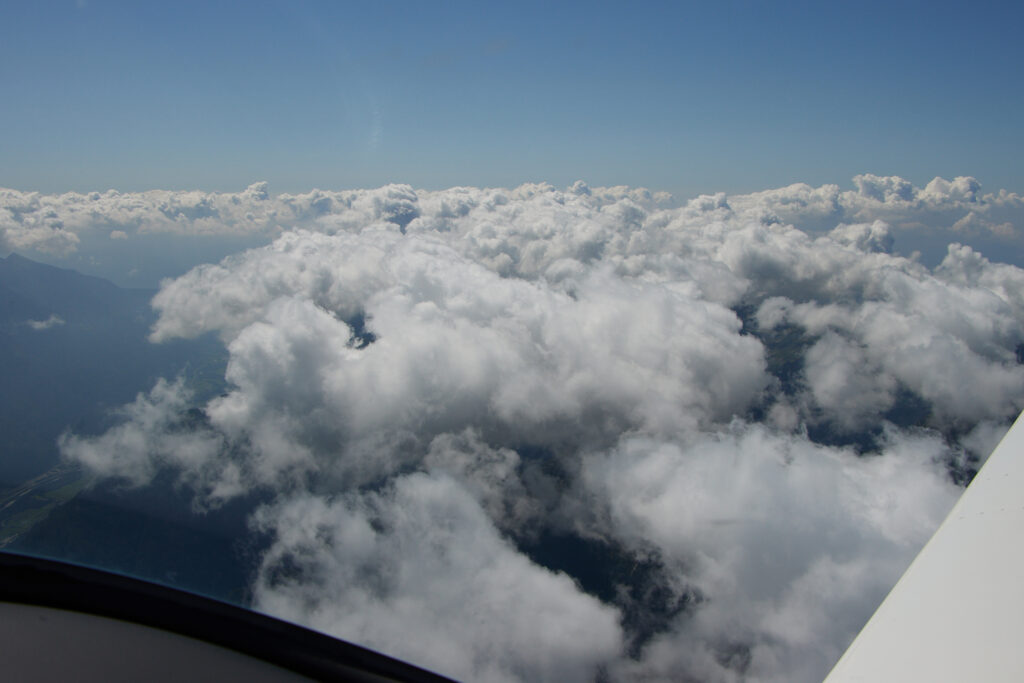
the San Bernardino pass and the Avers valley towards Maloja in the Engadin valley.

Below St. Moritz can be seen on the left side of the lake, with Runway 03 of Samedan airport visible above the lake. Today Runway 21 was in use, so we flew into the downwind on the right side of the valley.
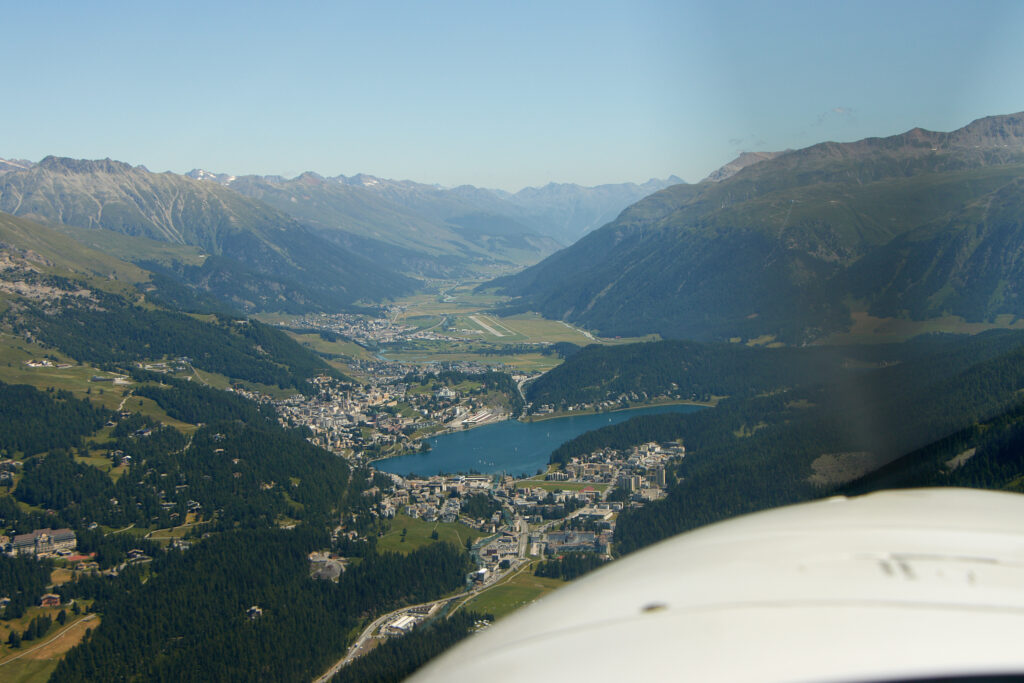
When we arrived we were the only small aircraft on the grass parking, by the time we left three more had arrived. Two were also homebuilts (RV-7/7a), the one in the rear was the Diesel powered Robin from Lommis.
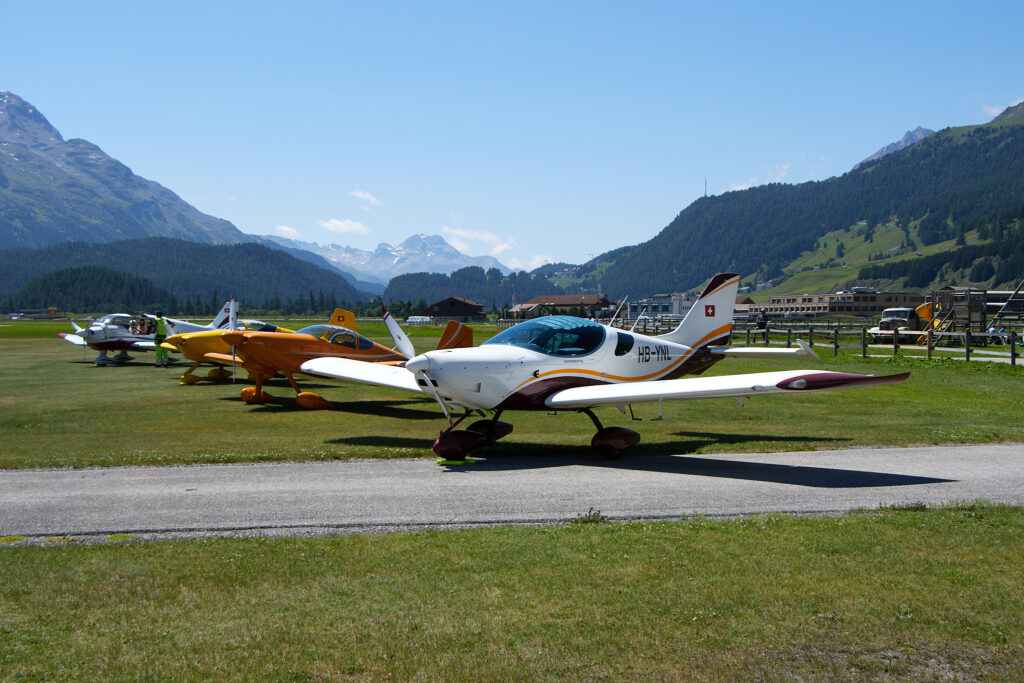
Our lunch break on the terrasse of the airport restaurant was interrupted by the arrival and departure of a Dassault Falcon 2000 EX, they only did a quick stop to pick up or drop off some passengers.
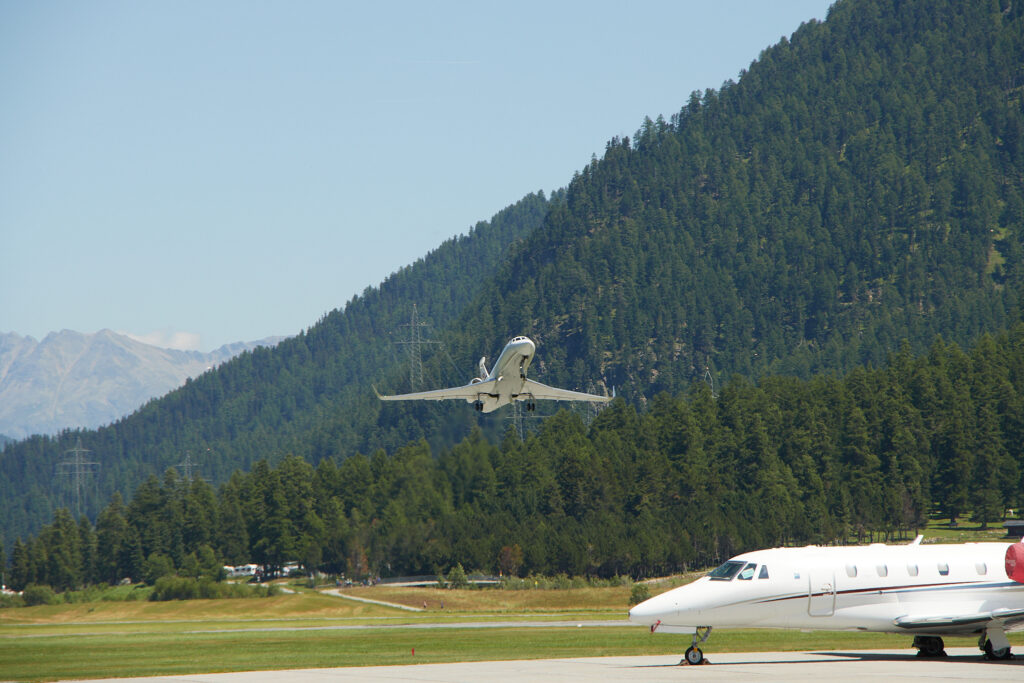
After our lunch break we returned to Lommis, arriving with significantly less cloud cover than we had when we departed in the morning. As we did quite some detours we spend slightly more than four hours in the air, with fuel for nearly two more hours.
30.07.2021: Having recently used the release of Microsoft Flight Simulator 2020 as an excuse to buy a new computer, I of course had to cross check what the approach to Samedan looks like in the virtual world. I’m honestly impressed, it is unbelievable the progress Flight Simulator has made over the last 40 years.

Flight Simulator has been published in 1979 by subLogic as Flight Simulator, and in 1982by Microsoft as Microsoft Flight Simulator 1.0. I have use Flight Simulator in it’s original, monochrome version on an Apple II computer owned by a friend, where the environment was only shown as wire mesh, as in the picture below:

I then bought my first copy of Flight Simulator in 1987, version FS II, for my Amiga 500 computer, using our 14″ colour TV as display. That looked roughly as shown on the picture below, both pictures are taken from a very nice description of the history of Flight Simulator on https://flightsim.gl/flight-simulator-history/.

I bought my first Microsoft PC compatible computer around 1989 or 1990, with an 80286 CPU, 640 kB of RAM and an “huge” 20 MB HDD. From then on I bought most versions of Flight Simulator, starting with FS 4, followed by FS 5.1, Flight Simulator for Windows 95 etc. I have never been one of those hardcore Flight Simulator users, who spend their nights flying airliners around the world, but I still enjoyed each new version with i’s continuously improving graphics and flight realism.